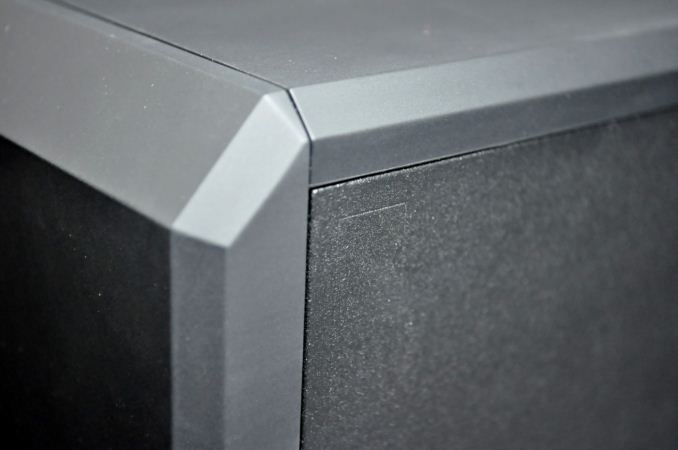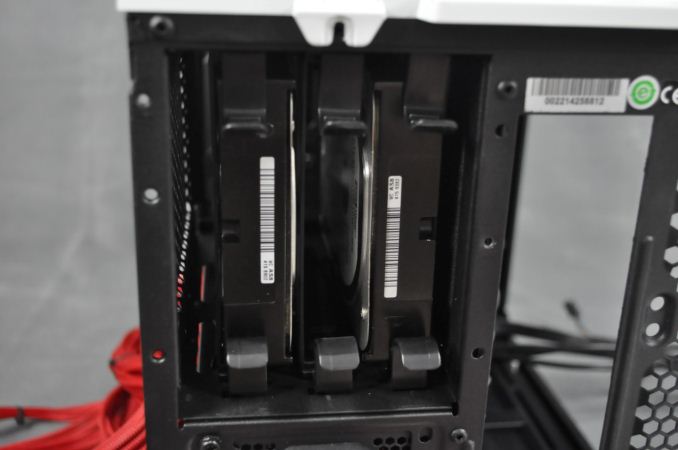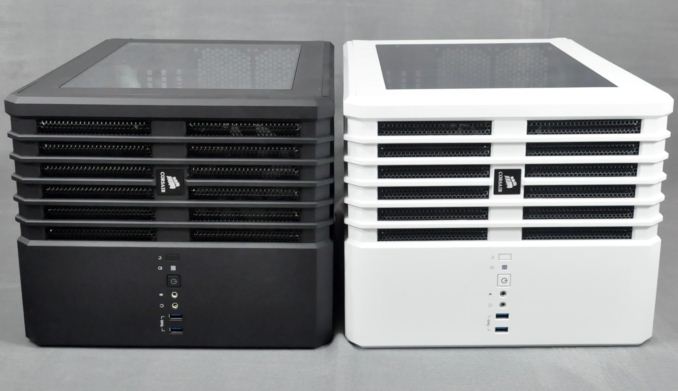Corsair Carbide Air 240 Case Review
by E. Fylladitakis on August 15, 2014 6:00 AM EST- Posted in
- Cases/Cooling/PSUs
- Corsair
- ATX
- Case
- Carbide
Corsair Carbide Air 240 Exterior
"And we shall call it…mini-540". This is what Corsair must have been thinking while designing their latest addition to the Carbide series, the Air 240. The new Micro-ATX case looks exactly like an undersized version of the Carbide Air 540 that we reviewed a little over a year ago. With a size of 315mm × 265mm × 400mm (H×W×D) and a total volume of 0.0334m3, the Carbide Air 240 is not a very compact Micro-ATX case, yet it takes less than half the volume of the Air 540 (61.55% less) and less volume than the Obsidian 350D (21.87% less). It also adds Micro-ATX compatibility over the Obsidian 250D for just 16.9% more volume.
Corsair currently offers the Carbide Air 240 in two colors, black and white, both of which are depicted in the following galleries. It is interesting to note that the metallic parts of the black version have been sprayed with a grainy, satin black paint, while a smooth matte black paint covers the plastic parts. The difference in the paint on the black isn't a major deal, but it is apparent when performing a close inspection. The white version on the other hand is immaculate, with the entire exterior having being sprayed with a satin white color.
Aesthetically, the Carbide Air 240 sports an interesting asymmetric design that hints at the internal dual-chamber configuration. The left part of the faceplate is vented, as is the left part of the top and bottom panels as well, creating exceptional cooling possibilities for the main system. We can see the I/O ports and buttons on the right middle side of the faceplate, with the company logo in alignment towards the left side of the case. The left side panel is almost entirely covered by a transparent acrylic window, revealing the entire main system to the spectator.
The top and bottom panels of the Carbide Air 240 are secured with two thumbscrews each. By removing these thumbscrews, both panels easily slide off. However, as the case actually sits on the bottom panel, it will have to be placed on its side or upside down before removing it. The removal of either panel reveals the frame for the installation of 120mm fans and/or liquid cooling radiators.
It is very interesting that Corsair went with a "rails" design, allowing the user to adjust the location of the fans/radiator by a few centimeters towards the front or the rear of the case. Each of the side panels is secured with two thumbscrews each as well, but these thumbscrews are partially threaded and do not come off the panel when removing it. The front panel can also be removed, but the user needs to first remove both side panels and undo the plastic clips that hold the front panel in place.
Even though the right side panel of the Carbide Air 240 will have to be removed before the user can wire any of the drives, both drive cages are accessible from the exterior of the case. The 2.5" drive cage is beneath the top panel, which has to be removed in order to gain access to it. The 3.5" drive cage is accessible from the rear of the case, by removing a perforated metallic cover held in place with a single thumbscrew. The plastic trays of the 3.5" cage can hold 2.5" drives as well. Strangely, even though the plastic trays have been inserted facing rightwards from the factory, they need to be installed facing leftwards in order to fit three full-size 3.5" mechanical disks.
It is also possible to use the Carbide Air 240 sideways and there are even slots on the metallic right side panel for the rubber feet that Corsair provides in the bundle. However, that will also rotate the faceplate and everything printed on it, including the I/O legend and the case badge, making the Carbide Air 240 look rather odd and off-place. The case badge is magnetic and may be rotated, but that is not true for the I/O legend and buttons.



























63 Comments
View All Comments
HisDivineOrder - Sunday, August 17, 2014 - link
They take up too much space for too little gain. That space could be more 3.5" slots or even an open place for a fan.lexluthermiester - Wednesday, August 20, 2014 - link
Yup that's what he said. Wake up before you open your flap-trap.Etern205 - Friday, August 29, 2014 - link
I guess you haven't been old enough or encounter more, to know the nightmare it was to deal with external optical drives when they first arrived. I still remember when I had to use a external optical drive a few times to reinstall the OS on laptops where their internal optical drives had died or those that don't come with one. The problem is they're not that well built and the laptop itself as well as the bios also played a part.So this is what happens.
1. Not all USB ports plays nicely with USB optical drives, some will let it detect, but after a few minutes it mysteriously disconnects and then I had to power off the laptop and power it back on to let it find it again.
2. Some USB ports refuses to even detect any USB optical drives even after I changed to different brands, them USB cables, or even use one of those a internal optical drives connected via a SATA to USB adapter kit.
3. If I was lucky enough to begin the installation, I have to have my fingers crossed hoping the USB optical drive does not crap out during the middle of the installation and if it did, I have to restart the installation. The worst parts is finishing the installation up to 99% and then the USB optical drive craps out, so basically that's like a whole hour or so wasted for nothing.
4. Some laptops and USB optical drives have a mind of its own. they either want to work or don't work. With all these problems and weird behaviors, what used to be a simple install of the OS, has become a day of hell, just to get something that simple to complete, if their internal optical drive was working or it had one in the first place.
While they might have now improved, they had left a bad rep, therefore I still prefer a internal optical drive and cases should comes with at least one 5.25" bay. If you don't see the need to use a internal optical drive, then that 5.25" bay can be used for something else like adding a Hotswap SSD/HDD kit. or a LCD fan controller.
http://www.newegg.com/Product/Product.aspx?Item=N8...
I say Kill USB optical drives with fire and throw them stupid crap built laptops in alone with it.
Refuge - Friday, August 21, 2015 - link
I remember building in the 90's.To think external optical drives today are anything like the external drives of old, I guess you are just too old to build computers today?
Also back then, the simple work around was to take an internal drive, and just set it in the bottom of the case and hook it into the Mobo that way. I think you just lack imagination.
Kevin G - Friday, August 15, 2014 - link
I'll second the idea of additional 3.5" bays behind the motherboard. Also make them hot swap and then the case would be ideal for a DIY NAS or HTPC with redundant storage.lexluthermiester - Wednesday, August 20, 2014 - link
Totally with you!coburn_c - Friday, August 15, 2014 - link
Why do they ruin everything with garish plexy. Case windows should be an add-on option, industry wide.Infernus - Friday, August 15, 2014 - link
I agree, that's the only gripe I have with my 540 (and soon to be 240 when it eventually arrives).On a side note, I don't know why Apple doesn't offer the original NeXT Cube case in mATX/ATX format - I know I would pay good money for it.
notlurking - Friday, August 15, 2014 - link
Apple doesn't even have to do it! The NeXT Cube design patents expired years ago. I don't understand why, despite ten years of everyone saying they want a cube, that no manufacturer makes one. The next cube was 12"x12"x12" with a microATX sized motherboard, 1x3.5" bay and 1x5.25" bay.The 1x3.5" bay is need for SD slot or fan controller. Every laptop and All-in-one PC for the past ten years has had an SD slot yet only LianLi builds an SD slot in their case. The 1x5.25" bay is necessary because someone needs to do the rips that everyone else downloads.
Many people have bought NextCubes and modded them into PC's. I don't have time for modding but I'd pay for a 13"x13"x13" cube case.
The Carbide Air is so close to perfect, but I won't buy a 15.75" deep case that doesn't have a 5.25" bay.
zlandar - Friday, August 15, 2014 - link
The 12.4" height is too large to fit most entertainment consoles. My console has two fairly large shelves and the max height is 8.5". Not a ding since the author mentioned the case was not specifically designed for HTPC use but something to consider for people considering it.